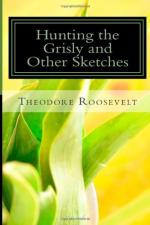I have known of these feats being performed several times in northern Wyoming, although never in the immediate neighborhood of my ranch. Mr. Archibald Roger’s cowhands have in this manner caught several bears, on or near his ranch on the Gray Bull, which flows into the Bighorn; and those of Mr. G. B. Grinnell have also occasionally done so. Any set of moderately good ropers and riders, who are accustomed to back one another up and act together, can accomplish the feat if they have smooth ground and plenty of room. It is, however, indeed a feat of skill and daring for a single man; and yet I have known of more than one instance in which it has been accomplished by some reckless knight of the rope and the saddle. One such occurred in 1887 on the Flathead Reservation, the hero being a half-breed; and another in 1890 at the mouth of the Bighorn, where a cowboy roped, bound, and killed a large bear single-handed.
My friend General “Red” Jackson, of Bellemeade, in the pleasant mid-county of Tennessee, once did a feat which casts into the shade even the feats of the men of the lariat. General Jackson, who afterwards became one of the ablest and most renowned of the Confederate cavalry leaders, was at the time a young officer in the Mounted Rifle Regiment, now known as the 3rd United States Cavalry. It was some years before the Civil War, and the regiment was on duty in the Southwest, then the debatable land of Comanche and Apache. While on a scout after hostile Indians, the troops in their march roused a large grisly which sped off across the plain in front of them. Strict orders had been issued against firing at game, because of the nearness of the Indians. Young Jackson was a man of great strength, a keen swordsman, who always kept the finest edge on his blade, and he was on a swift and mettled Kentucky horse, which luckily had but one eye. Riding at full speed he soon overtook the quarry. As the horse hoofs sounded nearer, the grim bear ceased its flight, and whirling round stood at bay, raising itself on its hind-legs and threatening its pursuer with bared fangs and spread claws. Carefully riding his horse so that its blind side should be towards the monster, the cavalryman swept by at a run, handling his steed with such daring skill that he just cleared the blow of the dreaded fore-paw, while with one mighty sabre stroke he cleft the bear’s skull, slaying the grinning beast as it stood upright.
CHAPTER V.—THE COUGAR.
No animal of the chase is so difficult to kill by fair still-hunting as the cougar—that beast of many names, known in the East as panther and painter, in the West as mountain lion, in the Southwest as Mexican lion, and in the southern continent as lion and puma.




